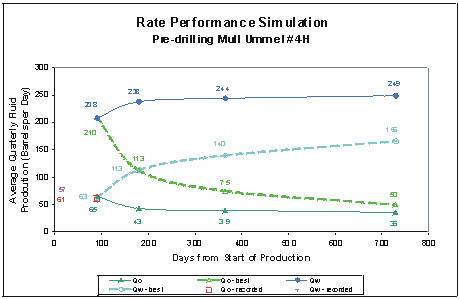 University of Kansas Petroleum Technology News |
|
|
|
 University of Kansas Petroleum Technology News |
|
|
|
 |
| Structure map on top of Mississippian reservoir unit showing field outline, leases and wells in the Ness City North Field. The Ummel lease and Mull Ummel #4-H well are highlighted. The Ummel #4 was reentered and a horizontal lateral drilled toward the center of the field (well path is shown schematically). Numerous other Mississippian reservoirs surround the immediate vicinity of the site. |
 |
| Pre-drill simulation output for Mull Ummel #4H showing production rates for oil and water. Simulation was for a horizontal well with an effective horizontal well length of 400 feet, a uniform skin of 4.5 across the producing length, and a Pwf of 675 psi. Fluid production rates are plotted for the expected (Qo, Qw) and the best-case (Qo-best, Qw-best) simulations. Average production rates observed in the first month are shown (Qo-recorded, Qw-recorded). |
|
North Midcontinent Resource Center Petroleum Technology Transfer Council Rodney Reynolds, Director Dwayne McCune, Engineer Lisa Love, Office Manager Partially funded by the Department of Energy, Office of Fossil Energy through the National Petroleum Technology Office & Federal Energy Technology Center |
Energy Research Center Kansas Geological Survey Dr. Tim Carr, Chief of Petroleum Research Dr. W Lynn Watney, Executive Director ERC |
Tertiary Oil Recovery Project Dr. Don Green, Co-Director Dr. G. Paul Willhite, Co-Director |
|
Director, Rodney Reynolds c/o Energy Research Center 1930 Constant Avenue Lawrence, KS 66047 Phone: 785-864-7398 Fax: 785-864-7399 Email: Reynolds@cpe.engr.ku.edu |
|
e-mail : webadmin@kgs.ku.edu Last updated July 2000 http://www.kgs.ku.edu/PTTC/News/2000/q00-2-1.html |